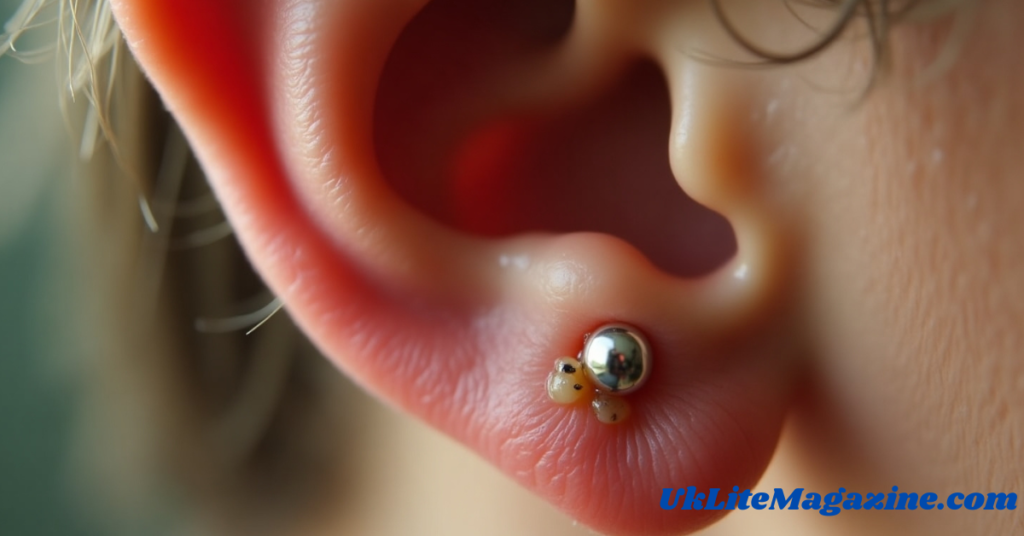Helix piercings are a stylish way to enhance your look, but like any body modification, they come with risks. One of the most common issues is infection, which can cause pain, swelling, and complications if left untreated. This article will guide you through the signs of helix piercing infection, effective treatments, and essential prevention tips.
Signs of a Helix Piercing Infection
Recognizing an infection early is crucial for quick treatment. Here are the common symptoms:
1. Redness and Swelling
- Mild redness and swelling are normal after a fresh piercing, but excessive redness, heat, and prolonged swelling can indicate an infection.
2. Pain and Tenderness
- Some discomfort is expected in the healing phase, but sharp pain or extreme tenderness around the piercing site could be a warning sign.
3. Pus or Unusual Discharge
- Clear fluid is normal, but yellow, green, or foul-smelling pus is a sign of infection.
4. Persistent Itching or Burning
- If the area feels constantly itchy or burning, it may indicate bacterial irritation or infection.
5. Bumps or Abscess Formation
- Small lumps or abscesses filled with pus around the piercing could indicate an infection or keloid formation.
6. Fever and Fatigue
- A severe infection can cause systemic symptoms like fever, chills, or body aches. If this happens, seek medical help immediately.
How to Treat an Infected Helix Piercing
If you suspect an infection, follow these steps to prevent it from worsening:
1. Clean the Area Properly
- Use a saline solution (a mix of sterile water and salt) to gently clean the piercing twice a day.
- Avoid using alcohol, hydrogen peroxide, or harsh chemicals, as they can dry out and irritate the skin.
2. Apply a Warm Compress
- A warm compress helps reduce swelling and promotes healing. Use a clean cloth soaked in warm salt water and apply it to the infected area for 5–10 minutes.
3. Avoid Touching or Rotating the Jewelry
- Touching the piercing with unclean hands introduces bacteria.
- Do not twist or move the jewelry excessively, as this can worsen the infection.
4. Use Antibiotic Ointment (If Recommended)
- A doctor may suggest a topical antibiotic cream like Neosporin. Apply it in moderation to avoid clogging the piercing.
5. Take Over-the-Counter Pain Relievers
- If the infection causes discomfort, ibuprofen or acetaminophen can help relieve pain and swelling.
6. Seek Medical Help for Severe Symptoms
- If the infection worsens, spreads, or you experience fever, consult a healthcare provider. Oral antibiotics may be necessary.
Prevention Tips for Avoiding Helix Piercing Infections
Preventing infection is easier than treating it. Follow these essential tips:
1. Choose a Professional Piercer
- Ensure your piercer uses sterile equipment and follows hygiene standards.
- Avoid using a piercing gun, as it can damage the cartilage.
2. Use High-Quality Jewelry
- Choose jewelry made from hypoallergenic materials like titanium, surgical steel, or gold to prevent allergic reactions.
3. Maintain Proper Aftercare
- Follow the piercer’s instructions and clean the piercing regularly with saline solution.
4. Avoid Sleeping on the Piercing
- Sleeping on the affected side can irritate the piercing and introduce bacteria from pillowcases.
- Use a travel pillow or soft cloth as a barrier.
5. Keep Hair and Hands Away
- Hair can trap dirt and bacteria, increasing infection risk.
- Wash hands before touching the piercing.
6. Change Pillowcases Frequently
- Bacteria can accumulate on pillowcases, so change them at least twice a week.
7. Stay Away from Swimming Pools and Hot Tubs
- Chlorinated water and bacteria in pools or hot tubs can increase the risk of infection.
Important Information Table
| Aspect | Details |
|---|---|
| Healing Time | 6 months to 1 year |
| Signs of Infection | Redness, swelling, pus, pain, fever |
| Cleaning Solution | Saline solution (sterile water + salt) |
| Jewelry Material | Titanium, surgical steel, gold |
| Avoid | Touching, rotating, alcohol-based products, pools |
| Seek Medical Help If | Fever, severe swelling, spreading redness |
Conclusion
A helix piercing is a stylish body modification, but infections can occur if proper care is not taken. By recognizing early signs, using appropriate treatment methods, and following preventive measures, you can ensure a smooth healing process. If an infection worsens, seek professional medical help to prevent complications.
Frequently Asked Questions (FAQs)
1. How long does a helix piercing take to heal?
- A helix piercing typically takes 6 months to 1 year to fully heal, depending on aftercare and individual healing speed.
2. Can I remove my jewelry if my helix piercing is infected?
- No, removing jewelry can trap bacteria inside the wound and worsen the infection. Treat the infection first and consult a professional.
3. Is it normal for a helix piercing to be red and swollen?
- Mild redness and swelling are normal in the first few weeks. However, if symptoms persist or worsen, it may indicate an infection.
4. What should I do if my helix piercing develops a bump?
- A bump may be a keloid or an infection. Apply warm compresses, use saline solution, and consult a piercer if it persists.
5. Can I sleep on my helix piercing?
- It is best to avoid sleeping on the pierced ear to prevent irritation and infection. Use a travel pillow to protect the area while sleeping.
By following these tips and taking proper care, you can enjoy your helix piercing without complications. Always prioritize hygiene and listen to your body’s signals to ensure a smooth healing process.

